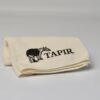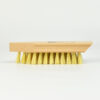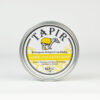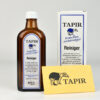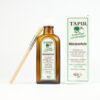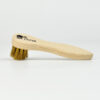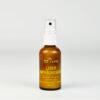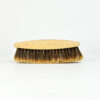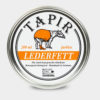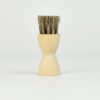Questions and answers
Tips and tricks for caring for barefoot shoes
Shoe care - the best tricks for durable barefoot shoes
Cleaning and care of barefoot shoes
Proper care of barefoot shoes is important because it not only affects the longevity of the shoes, but also ensures your comfort and hygiene. These points are explained in more detail below.
Since barefoot shoes are often made of high-quality materials and have special properties, they are often more expensive to buy in the higher range. Regular care protects the material from wear, cracks or brittleness – especially in the case of wool, leather or suede – and thus gives them a longer service life. Because barefoot shoes are designed to be flexible, lightweight, and breathable, these features could be lost due to incorrect or inadequate care. Dirt particles could, for example, block breathability, or water could swell the material. Barefoot shoes for children in particular are often in contact with sand and therefore deserve special care.
Because barefoot shoes are often worn barefoot or with very thin socks, moisture and sweat accumulate more quickly. Good care, such as regular cleaning and drying, can prevent odors and the formation of bacteria or mold.
Since barefoot shoes are often exposed to wind, weather and dirt during outdoor activities, regular cleaning and impregnation is of great importance.
Good shoe care also helps to ensure that the shoes can be used longer and do not have to be replaced prematurely. This is not only easy on the wallet, but also contributes to greater sustainability, as less waste is generated and resources are conserved.
Well-cared for barefoot shoes not only look better, but also feel more comfortable. Dirt residues, hardening or unpleasant odors can impair wearing. With the right care, the barefoot feeling remains pleasant for a long time.
So if you take care of your barefoot shoes regularly, you will ensure a longer durability, maintain their functionality and you will have comfortable and hygienic shoes for a long time. Since barefoot shoes are directly related to the health of the feet, this is all particularly important.
To ensure that your barefoot shoes are a loyal companion for a long time, you should clean them regularly with the right means and methods.
The upper material of your barefoot shoes can be gently wiped by hand with a slightly damp cloth . Do not put your shoes in the washing machine, as this can damage the material or destroy the shape of the shoes. Aggressive chemical cleaning agents should also be avoided for the same reason. Of course, the sole of the shoe should not be forgotten. Here it is a good idea to remove dirt from them with a dirt brush .
Attention – if your shoes are made of leather, there are still some details to consider. There are also serious differences in the cleaning of smooth leather shoes and those made of suede. For more information, simply read the following questions on this blog .
After cleaning, the shoes should be treated with a suitable natural waterproofing spray. This protects them from the penetration of moisture and dirt.
To ensure that the inside of your barefoot shoes remains nice and clean and hygienic, you should not forget the insole during the cleaning routine. Take them out and wash them by hand in a mild soap solution. After washing, the sole should dry well in the air – but never in direct sunlight or directly next to heating sources. For example, it helps to sprinkle some baking soda or baking soda into the sole overnight and remove the powder the next day against unpleasant odors.
Your leather barefoot shoes deserve special care. Here you will find shoe care recommendations for barefoot shoes made of smooth leather.
First, remove the insoles and laces. This makes cleaning easier.
Leather is a natural material that is breathable and durable on the one hand, but can also be sensitive to moisture and improper care on the other.
With a damp cloth or a soft brush, easily soiled areas can be removed. In the case of heavier soiling, special leather cleaners such as our leather and saddle soap can be used for smooth leather or for secured materials of moisture protection. Barefoot shoes made of leather should never be dried directly in direct sunlight or on the radiator, but better in a dark place in the air, otherwise the leather can become brittle. The leather should be treated regularly with nourishing leather care products such as leather grease, leather care cream or impregnation to keep the material supple and water-repellent.
Below are recommendations for your shoe care for suede barefoot shoes.
First, remove the insoles and laces. This makes it easier to clean it later.
Suede is a natural material that is breathable on the one hand, but can also be very sensitive to moisture and improper care on the other.
With suede, damp cleaning should always be avoided, as the sensitive leather absorbs water directly and can thus destroy it. However, our suede eraser helps with heavier soiling. Simply rub it gently over the soiled areas. This will loosen the dirt that has settled in the leather. You can then remove the loosened dirt with a clean, dry cloth or a soft shine brush. Our suede eraser has two sides of different hardness. For more stubborn stains, simply use the harder side made of natural rubber.
After cleaning, care for your barefoot shoes with the Tapir impregnation and, after it has dried, simply put the fibers back on with the suede eraser.
Barefoot shoes made of suede should never be dried directly in direct sunlight or on the radiator, but better in a dark place in the air, otherwise the leather can become brittle.
If you are interested in more information about suede, you can find more exciting facts about suede on our blog.
Barefoot shoes made of fabric are often lighter, but they are more susceptible to dirt and they can absorb moisture more strongly.
On the road with our cleaner for mixed materials from outside! and a dirt brush or a swelling sponge can be used to clean coarse soiling. Light dirt can also be removed with a small brush. Some fabric barefoot shoes are even machine washable. But please always check this directly in the care instructions of the shoes! If allowed, wash them at a low temperature (max. 30 °C) on a gentle cycle and protect the shoes in a laundry bag.
The shoes should air dry and should never be put in the dryer, as this could cause the material to shrink or deform
After cleaning, our moisture protection, which is a protection for your shoes for wool, cotton or even mixed materials, protects.
Barefoot shoes made of synthetic materials such as mesh or vegan imitation leather are often easier to care for and more resistant to external influences.
For rough cleaning, the shoes can be cleaned with a damp cloth and our special cleaner . For mesh surfaces, a dirt brush is suitable to remove dirt from the gaps as well. The same applies to these shoes with regard to washing machines: Only if the manufacturer’s instructions allow it, these shoes can also be washed in the machine on a gentle cycle. Otherwise by hand with our tapir products!
Since synthetic materials could melt or lose their shape at high temperatures, they should not be put in the dryer under any circumstances, but should be air-dried.
After cleaning, the moisture protection also ensures impregnation, i.e. additional protection against dirt and moisture.
So you see – with the knowledge of which material it is and with our suitable natural materials, you are well equipped for the shoe care of your barefoot shoes made of textile, cotton, functional fabric or mixed materials!
Especially before longer storage periods, you should pay attention to certain points so that your barefoot shoes are well preserved for a long time.
Before putting the shoes away, they should be thoroughly cleaned to remove dirt, moisture and bacteria responsible for odours. The dirt can damage the material over time, and moisture can lead to mold growth. The shoes should therefore also be completely dry before storage. Depending on the material, your barefoot shoes also deserve special care before storage. Leather shoes should be treated with leather grease or leather impregnation so that the leather remains supple over time and does not dry out. Barefoot shoes made of textile or synthetic fabrics can be protected from dirt and moisture with the moisture protection.
After cleaning and maintenance, a suitable storage site should be found. This should be cool and dry and protected from direct sunlight. Damp cellars or hot attics should be avoided, as these can damage the material.
Shoe trees help to preserve the original shape of the shoes. If there are no shoe trees, the shoes can also be loosely stuffed with absorbent paper.
To protect the shoes from dust, they should ideally be stored in their original boxes or in breathable fabric shoe bags. Plastic bags should be avoided at all costs, as moisture is trapped here and can lead to shoe odor or mold growth. It would also make sense to store the insoles separately if possible.
If these simple tips are followed, your barefoot shoes will remain in top condition even after prolonged storage and will be ready for use again!
Are there waterproofing sprays that are suitable for barefoot shoes?
Of course, there are waterproofing sprays that are directly suitable for your pair of barefoot shoes. First, however, you should check what material your shoes are, as different materials have different requirements for waterproofing spray.
For barefoot shoes made of smooth leather , our leather impregnation for smooth leather is suitable, but depending on the leather and the desire for shine, the leather grease or the leather care cream could also be interesting.
For suede, nubuck leather and suede, please use this impregnation. For barefoot shoes made of cotton, linen, blended fabrics and functional fabrics, our Out and about! Wetness protection Excellent.
With our impregnations, you are doing the environment and your health a favour, as they are guaranteed to be free of PFAS and other harmful ingredients and gently but effectively protect your barefoot shoes from moisture and moisture. Before you apply the impregnation or care, your shoes should be sufficiently cleaned, preferably with our cleaner and completely dry.
Regular care of barefoot shoes should be decided depending on the frequency of wear, so they can be cleaned regularly and then impregnated or creamed again.
With our care products, your barefoot shoes remain optimally protected from moisture, dirt and stains, maintain their breathability and at the same time help the environment through more sustainability.
How often should you care for barefoot shoes so that they last a long time?
Of course, how often you should care for your barefoot shoes depends on various factors such as the material, the frequency of use and the environmental conditions. Nevertheless, there are some guidelines that help to optimally care for barefoot shoes and thus extend their lifespan.
Especially with outdoor shoes, or children’s barefoot shoes after a rainy day on the playground, it is advisable to remove coarse dirt such as dust, soil or sand immediately after wearing . The best way to do this is with a dirt brush for shoes.
If the shoes have become damp due to rain or sweating, for example, they should be dried in the air and never in direct heat sources or in the blazing sun. Stuffing with newspaper will help maintain its shape and absorb moisture.
With regular use, the inside of the shoes should be wiped out more frequently, about every two weeks with a damp cloth and then dry thoroughly. This prevents sweat and moisture from attacking the inner material.
More thorough care should take place about every 4-6 weeks. Depending on the degree of soiling, this includes a deep cleaning with our leather soap or, in the case of materials other than smooth leather, our cleaner.
After cleaning, the material should be cared for, either with impregnation, leather grease, leather care cream for leather shoes or our moisture protection for shoes made of fabric or synthetics.
About every 3-6 months , the shoes should be checked for wear or damage. Insoles should be replaced if they are no longer comfortable due to sweat or wear in order to continue to ensure hygiene and comfort.
It is a good idea to change shoes regularly and not wear the same pair every day so that they have enough time to dry completely.
Here is a small summary of the care:
- Daily: remove coarse dirt, let it dry thoroughly.
-
Weekly: Clean the interior, refresh the impregnation if necessary.
-
Monthly: Material care and more thorough cleaning.
-
Seasonal: deep maintenance, inspection and small repairs.
With these care tips, your barefoot shoes will function for longer, look good and stay comfortable, so they will continue to be fun to wear.
How do you care for barefoot shoes in a sustainable and environmentally friendly way?
Barefoot shoes not only stand for foot health, but also for sustainability and environmental protection. In order to reduce your ecological footprint when caring for barefoot shoes and at the same time extend the life of the shoes, you will now find some environmentally friendly tips for caring for your barefoot shoes.
- On the one hand, when purchasing barefoot shoes, you can make sure that they are made of environmentally friendly materials, such as recycled fabrics, leather or natural rubber.
- Aggressive and environmentally harmful cleaning agents should always be avoided. Instead, depending on the material, you should use natural care products .
- Coarse loose dirt can be removed directly with a Dirt brush, first dry or removed with water and cleaner.
- After cleaning, the shoes should be left to air dry without using a dryer or heating sources. This is not only more sustainable, but also protects the material from damage.
- In the case of barefoot shoes made of leather, a treatment with a leather care product should be carried out afterwards. follow. This keeps the leather supple and ensures that your shoes remain functional for a long time.
- A natural impregnation, such as our impregnations (depending on the material of the barefoot shoes, suitable sprays should be used for each purpose!), then protects the shoes from moisture and dirt. Of course, our products contain 100% natural ingredients and thus contribute to a a major contribution to sustainability and to the protection of our environment. Regular impregnation also helps to reduce the need to clean the shoes.
Another aspect of paying attention to more sustainability in barefoot shoes is to repair minor damage with environmentally friendly repair glue or to take it to the cobbler in case of major damage instead of throwing it away directly. You can also replace the insoles if they are broken on the inside, instead of throwing away the entire shoes. It is best to use sustainable soles made of natural materials such as cork, wool or recycled material.
For example, if you want to store your shoes sustainably after the end of the season, it is best to store them in cloth bags or reusable boxes instead of plastic bags. This protects them from dust in an environmentally friendly way and at the same time reduces the risk of mould. Instead of using plastic shoe trees, it is better to use wood or stuff the shoes loosely with newspaper so that they retain their shape.
In summary, sustainable shoe care for barefoot shoes not only means that you will enjoy your well-preserved shoes for a long time, but at the same time save resources, avoid harmful chemicals and thus contribute to environmental protection.
Which care products are ecologically harmless and still effective?
Since barefoot shoes are often made of sensitive and sustainable materials such as leather or fabric, ecological but nevertheless effective care products for barefoot shoes are particularly important. Tapir has been bringing natural care products to the market for years, all of which are made from natural ingredients and in our manufactory.
From cleaning to care and impregnation, barefoot shoes made of different materials can be cared for in a natural way.
Whether smooth leather, suede or mixed materials, simply enter the search term and find the right product.
Especially our care line Tapir Draußen unterwegs covers the cleaning and care of barefoot shoes.
All Tapir products are NCP certified and have a full declaration. That means you know what’s in it and that’s a good thing. Here you can find an overview of our natural raw materials.

 Deutsch
Deutsch

